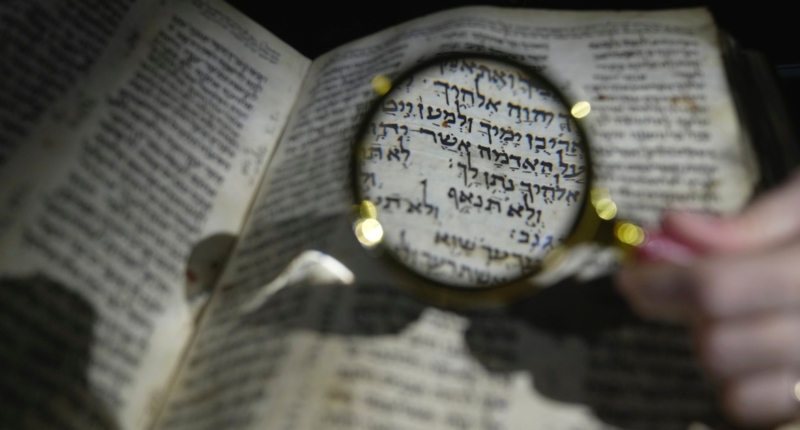The Codex Sassoon, a handwritten, leather-bound parchment tome containing almost the entirety of the Hebrew Bible, is set to go under the hammer at Sotheby’s in New York in May. This 1,100-year-old biblical manuscript is expected to fetch between $30-50 million at auction, making it the most expensive Jewish document ever sold if the target price is realized. Although the Aleppo Codex is more precise than the Sassoon Codex, the Sassoon Codex’s completeness is significant, containing 792 pages that make up around 92% of the Hebrew Bible. Judaica manuscripts’ prices have skyrocketed in recent years, but Sotheby’s proposed range is “a different league.” Few institutions and only a small handful of ultrawealthy collectors could afford such a price tag. There is precedent, however, of museums joining forces to buy prized manuscripts or philanthropists donating their purchases to libraries and other bodies. The National Library managed to purchase seven of Sassoon’s manuscripts when his collection was auctioned off in the 1970s, “but this one got away. And so for us, this is an opportunity to bring this great treasure home.”
Sotheby’s Auctioning Off 1,100-Year-Old Hebrew Bible
Sotheby’s is gearing up for a record-breaking sale of one of the oldest surviving biblical manuscripts – a 1,100-year-old nearly complete Hebrew Bible known as the Codex Sassoon. The handwritten parchment tome is bound in leather and contains almost the entirety of the Hebrew Bible. The auction will take place in New York in May, with an estimated sale price of $30-50 million.
Sotheby’s is hoping to attract interest from institutions and collectors. The sale is a testament to the bullish market for art, antiquities, and ancient manuscripts, even in the current bear economy.
The Codex Sassoon is currently on a whirlwind worldwide tour, including stops in the UK, Israel, and the US, before it goes up for auction. The Tel Aviv ANU Museum of the Jewish People opened a week-long exhibition of the manuscript on Wednesday.
According to Yosef Ofer, a professor of Bible studies at Israel’s Bar Ilan University, the Codex Sassoon is one of only three ancient Hebrew Bibles from its time period. The others are the Aleppo Codex from the 10th century and the Leningrad Codex from the early 11th century. Only the Dead Sea Scrolls and a few fragmentary early medieval texts are older.
Jewish scholars known as Masoretes started codifying oral traditions a few centuries before the creation of the Codex Sassoon. These oral traditions include how to spell, pronounce, punctuate, and chant the words of Judaism’s holiest book. Unlike Torah scrolls, these manuscripts contain extensive annotation, instructing readers how to recite the words correctly.
The precise date and location of the Codex Sassoon’s creation remain uncertain. Sharon Liberman Mintz, a senior Judaica specialist at Sotheby’s, estimates that the parchment dates back to 880-960 based on radiocarbon dating. The writing style suggests that an early 10th-century scribe from Egypt or the Levant created the manuscript.
Although ancient and rare, scholars note that the Codex Sassoon doesn’t match the pedigree and quality of its contemporary, the Aleppo Codex. According to Kim Phillips, a Bible expert at the Cambridge University Library, the scribal quality of the Codex Sassoon was “surprisingly sloppy” compared to its counterpart.
Codex Sassoon, the Rare Biblical Manuscript, Set to Break Auction Records
The Codex Sassoon, a handwritten, leather-bound parchment tome containing almost the entirety of the Hebrew Bible, is set to go under the hammer at Sotheby’s in New York in May. This 1,100-year-old biblical manuscript is expected to fetch between $30-50 million at auction.
This venerable manuscript has an interesting history. Protected and treasured by Syrian Jewish communities for centuries, the manuscript’s survival over the ages is remarkable. The manuscript’s ownership can be traced back to the 13th century when it was dedicated to a synagogue in the town of Makisin in northeast Syria. It was later entrusted to Salama ibn Abi al-Fakhr and was eventually sold to a legendary collector of Jewish manuscripts, David Solomon Sassoon, in 1929.
The Codex Sassoon’s margins contain annotations from a later scholar who checked its text against the Aleppo Codex, which has been considered the gold standard of the Masoretic Bibles for around 1,000 years. While scholars agree that the Aleppo Codex is more precise than the Sassoon Codex, the Sassoon Codex has great significance in its completeness, containing 792 pages that make up around 92% of the Hebrew Bible.
This manuscript is a testament to the still-bullish market for art, antiquities, and ancient manuscripts, even in the current bear economy. Sotheby’s is drumming up interest in hopes of enticing institutions and collectors to bid. It has put a hefty price tag on the manuscript, making it the most expensive Jewish document ever sold if the target price is realized.
Jacqui Safra, a banker and art collector, bought the Codex Sassoon for $3.19 million in 1989 and is now putting it up for auction. If the manuscript sells for the expected price, it could break the record for the priciest historical document ever sold at public auction, currently held by a 1787 copy of the U.S. Constitution sold in 2021 for $43 million.
The Codex Sassoon’s creation date remains uncertain, and its writing style suggests that an unspecified early 10th-century scribe in Egypt or the Levant created it. It is one of only three ancient Hebrew Bibles from its time period, the others being the Aleppo Codex from the 10th century and the Leningrad Codex from the early 11th century.
While the Sassoon Codex is ancient and rare, scholars note that it doesn’t match the pedigree and quality of its contemporary, the Aleppo Codex. Bible experts at the Cambridge University Library note that the scribal quality of the Sassoon Codex was “surprisingly sloppy” compared to its counterpart. Nonetheless, the manuscript is a significant piece of history that could make auction history in May.
Sotheby’s Record-Breaking Price Tag for Codex Sassoon
Sotheby’s record-breaking proposed price range of $30-50 million for the Codex Sassoon, one of the oldest surviving biblical manuscripts, has caused a stir in the Judaica manuscripts market. Yoel Finkelman, a former curator of Judaica at Israel’s National Library, said that prices for Judaica manuscripts have skyrocketed in recent years, but Sotheby’s proposed range is “a different league.” Few institutions and only a small handful of ultrawealthy collectors could afford such a price tag.
There is precedent, however, of museums joining forces to buy prized manuscripts or philanthropists donating their purchases to libraries and other bodies. The National Library managed to purchase seven of Sassoon’s manuscripts when his collection was auctioned off in the 1970s, “but this one got away. And so for us, this is an opportunity to bring this great treasure home,” said Raquel Ukeles, head of collections at Israel’s National Library.
Don’t miss interesting posts on Famousbio









